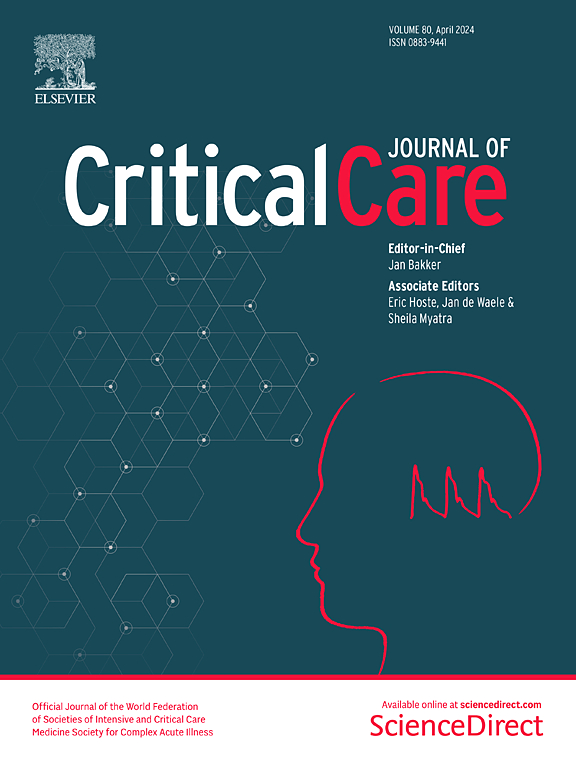Spontaneous diuresis in combination with furosemide stress test (SD-FST) as predictor for successful liberation from kidney replacement therapy: a prospective observational study
IF 8.8
1区 医学
Q1 CRITICAL CARE MEDICINE
引用次数: 0
Abstract
The optimal time for initiating kidney replacement therapy (KRT) in acute kidney injury (AKI) has been extensively studied in recent years. In contrast, there are currently insufficient data on the best time to discontinue KRT. One diagnostic option to unmask tubular reserve and indirectly estimate the glomerular filtration rate is the furosemide stress test (FST). We conducted a prospective, observational single-center trial. A FST was carried out in patients who developed spontaneous diuresis (SD) during ongoing KRT with a urine output of at least 400 ml in 24 h without any diuretic therapy. A positive FST was defined with urine output > 200 ml within 2 h following intravenous furosemide application. Follow-up was performed for 7 days and the need to restart KRT was assessed daily. After 100 patients were enrolled in the trial, 98 patients were eligible for further evaluation. 76 patients were FST-positive, while 22 patients were FST-negative. Resumption of KRT within the 7-day follow-up was required in only 14.5% of the FST-positive, but 72.7% of the FST-negative patients (p < 0.001). The urine output after FST was also significantly associated with successful release from KRT (AUC 0.87; p < 0.001). In critically ill patients with recovery of SD > 400ml/d during ongoing KRT, the FST helps to identify patients who can be successfully liberated from KRT. By detecting the tubular reserve using FST, the possibility of short-term kidney recovery after AKI can be estimated. German Clinical Trials Registry (DRKS00030560); date of registration 18/11/2022. https://drks.de/search/de/trial/DRKS00030560 .自发性利尿联合速尿压力试验(SD-FST)作为肾脏替代治疗成功释放的预测指标:一项前瞻性观察研究
近年来,人们对急性肾损伤(AKI)患者启动肾脏替代治疗(KRT)的最佳时间进行了广泛的研究。相比之下,目前关于停止KRT的最佳时间的数据不足。揭示肾小管储备和间接估计肾小球滤过率的一种诊断选择是速尿负荷试验(FST)。我们进行了一项前瞻性、观察性的单中心试验。在没有任何利尿剂治疗的情况下,在持续KRT期间出现自发性利尿(SD)且24小时内尿量至少为400ml的患者进行了FST。静脉滴注速尿后2小时内尿量为200毫升,即为FST阳性。随访7天,每天评估重新启动KRT的必要性。在100名患者入组试验后,98名患者有资格进行进一步评估。fst阳性76例,fst阴性22例。在7天的随访中,只有14.5%的FST阳性患者需要恢复KRT,但在正在进行的KRT期间,72.7%的FST阴性患者(p 400ml/d), FST有助于确定可以成功摆脱KRT的患者。通过FST检测肾小管储备,可以估计AKI后肾脏短期恢复的可能性。德国临床试验注册中心(DRKS00030560);注册日期:18/11/2022。https://drks.de/search/de/trial/DRKS00030560。
本文章由计算机程序翻译,如有差异,请以英文原文为准。
求助全文
约1分钟内获得全文
求助全文
来源期刊

Critical Care
医学-危重病医学
CiteScore
20.60
自引率
3.30%
发文量
348
审稿时长
1.5 months
期刊介绍:
Critical Care is an esteemed international medical journal that undergoes a rigorous peer-review process to maintain its high quality standards. Its primary objective is to enhance the healthcare services offered to critically ill patients. To achieve this, the journal focuses on gathering, exchanging, disseminating, and endorsing evidence-based information that is highly relevant to intensivists. By doing so, Critical Care seeks to provide a thorough and inclusive examination of the intensive care field.
 求助内容:
求助内容: 应助结果提醒方式:
应助结果提醒方式:


